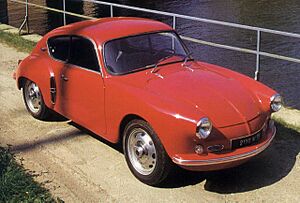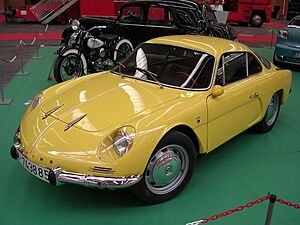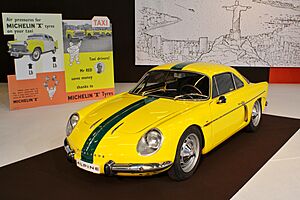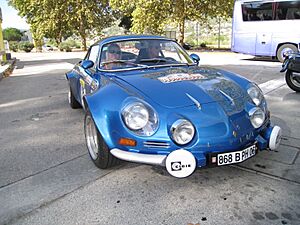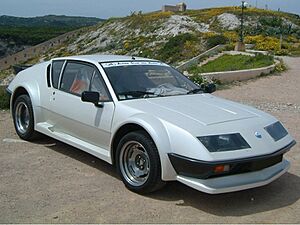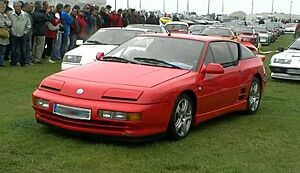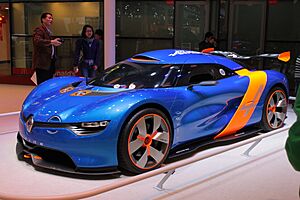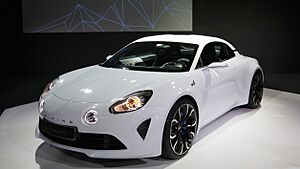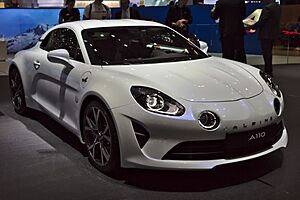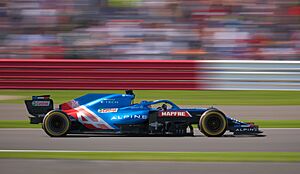Automobiles Alpine facts for kids
 |
|
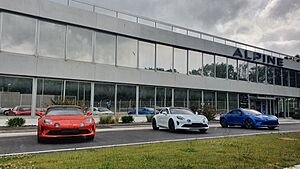
Alpine plant in Dieppe
|
|
| Subsidiary (société par actions simplifiée) | |
| Industry | Automotive |
| Founded | 22 June 1955 |
| Founder | Jean Rédélé |
| Headquarters | Dieppe, France |
|
Key people
|
Philippe Krief (CEO of the Alpine company and business unit) |
| Products | Automobiles |
|
Production output
|
|
|
Number of employees
|
356 (2021) |
| Parent | Renault Group |
| Divisions |
|
Alpine is a French company that makes cool sports cars and racing cars. It was started in 1955. The idea for the Alpine car brand came about in 1954.
Jean Rédélé was the person who founded Alpine. He owned a garage in Dieppe, France. Jean started winning races with a French car called the Renault 4CV after World War II.
Alpine has always been closely connected to Renault. Renault bought Alpine in 1973. In 1976, Alpine's racing part joined with Renault Sport. Alpine stopped making cars under its own name in 1995.
But don't worry, Alpine came back! In 2017, they launched a new car, the Alpine A110. In 2021, Renault announced that Renault Sport would join Alpine again. This created a new Alpine business unit.
Contents
History
Early days
Jean Rédélé used Renault 4CV cars to win many races. These included famous events like the Mille Miglia and Coupe des Alpes. He made many changes to the 4CVs, like adding special five-speed gearboxes.
To make the cars lighter, he built special versions with light aluminium bodies. He raced these at Le Mans and Sebring in the early 1950s. People liked these cars and wanted to buy them.
So, Jean created the Alpine brand in 1954. He named it "Alpine" because of his wins in the Coupe des Alpes race. He didn't know that another company, Sunbeam, had already used the name "Alpine" in England. This caused some problems for Alpine later on.
In 1955, Rédélé worked with a car body maker called Chappe et Gessalin. They were good at building cars using glassfibre. They made a small coupe called the Alpine A106, based on the 4CV's parts.
The A106 was very successful in the 1950s. A cool-looking convertible car was also added to the lineup. An Italian designer named Giovanni Michelotti helped design the car's look. Under the glassfibre body, there was a very strong frame. This special frame became a key feature of all Alpine cars.
Alpine then took Michelotti's convertible design. They made a closed coupe version called the 'berlinette'. This became the Alpine A108. It used the Dauphine Gordini engine. The A108 was built from 1958 to 1963.
1960s
In 1962, the A108 also started to be made in Brazil. It was built by Willys-Overland and called the Willys Interlagos.
Alpine was already working closely with Renault. When the Renault R8 car came out in 1962, Alpine updated their car's frame. They also made small changes to the body to use the R8's parts.
This new car was the A110 Berlinette Tour de France. It was named after a successful race in 1962. The A110 started with a 956 cc engine. Over the years, this car improved a lot. By 1974, it had powerful 1800 cc engines. The car was very light, so it was super fast!
Alpine became more and more successful in rallying. By 1968, Renault gave Alpine all its racing money. This close work with Renault meant Alpines could be sold and fixed at regular Renault dealerships. Alpine started winning big races in 1968. Their racing cars used special engines from the Renault R8 Gordini.
1970s
In 1971, Alpine cars finished first, second, and fourth in the Monte Carlo rally. They used engines from the Renault 16. In 1973, the newer A110 1800 won first, second, third, and fifth places. It then went on to win the World Rally Championship! Alpine beat big names like Porsche, Lancia, and Ford.
During this time, more Alpine A110s were made. Deals were made to build A110s and A108s in other countries. These included Spain, Mexico, Brazil, and Bulgaria.
In 1973, there was a big petrol crisis around the world. This affected many car makers. Alpine's car sales dropped a lot. Renault had to take over Alpine to help it. Alpine also had problems because they needed to make a new car to replace the A110.
Through the 1970s, Alpine kept racing the A110. Later, they raced its replacement, the Alpine A310. Other car makers started to build very special cars to compete with Alpine. One example was the Lancia Stratos. Alpine's cars were still based on their 1962 design. They used many parts from regular cars, which made them less competitive.
In 1974, Alpine built special racing Renault 17 Gordinis. One of these cars won a World Rally Championship race in the US.
After winning the rally championship, Alpine set a new goal: to win at Le Mans. Renault had also bought the Gordini tuning company. They combined Alpine and Gordini to create Renault Sport. Many successful racing cars were built. This led to a big win at Le Mans in 1978 with the Renault Alpine A442B. This car had a special turbo-charged engine. Alpine was actually the first company to win an international rally with a turbo car back in 1972.
In 1971, Alpine also started building open-wheel racing cars. They built cars for Formula Three and then Formula Two. In 1976, Jean-Pierre Jabouille won the European Formula 2 Championship. Alpine also built a Formula One car for testing. This led to their entry into the Formula One World Championship in 1977.
1980s
Alpine Renault kept making new car models throughout the 1980s. The A310 was a modern version of the A110. The Alpine A310 was a sports car with its engine at the back. It first used a 1.6 L engine from the Renault 17.
In 1976, the A310 got a new look and a more powerful V6 engine. This 2.6 L engine was changed by Alpine. It used a four-speed manual gearbox. Later, they used a five-speed gearbox.
After the A310, Alpine made the new Renault Alpine GTA range. These cars were made from plastic and polyester parts. They started with V6 engines. In 1985, a V6 turbo version was added. This car was faster and more powerful.
In 1986, robots started cutting polyester parts using high-pressure water jets. In the same year, a V6 turbo for America was developed. In 1987, special systems were added to reduce pollution. This allowed the V6 turbo to be sold in more countries.
In 1989, Alpine launched a special GTA Mille Miles car. This was to celebrate Alpine's 35th birthday. Only 100 of these cars were made. They had special features like ABS brakes and a fancy leather interior.
1990s
In 1990, the special wide-bodied GTA Le Mans was launched. It was similar to the V6 Turbo but had a catalytic converter. This reduced its power slightly. Only 325 of these cars were made, making them very rare.
The Alpine A610 came out in 1991. It had a new look inside and out, but you could still tell it was a GTA. The car's frame was greatly improved. Air conditioning and power steering were added as standard features. Only 818 A610s were made.
The last Alpine car, an A610, was made on April 7, 1995. Renault stopped using the Alpine name for a while. This was partly because of a problem in the UK. Alpine cars couldn't be sold there under their own name. Another company, Sunbeam, owned the "Alpine" trademark. For example, in the 1970s, Renault 5s were called "R5 Alpines" everywhere else. But in the UK, they had to be called "R5 Gordini".
The Alpine factory in Dieppe kept growing. In the 1980s, they built special R5 Turbo cars. They also built all Clio Williams and RenaultSport Spiders. The factory even put Alpine badges on some early Clio V6 cars.
Between 1989 and 1995, a new Alpine car was planned, called the A710 "Berlinette 2". Two test cars were built. It used a 2-liter engine from the Renault Clio Williams. But the project was too expensive and was cancelled. However, its engine and aluminium frame were later used in the Renault Sport Spider.
In 1999, Renault worked with Lotus on a design study. This was to see if the Alpine brand could return. The project was put aside and the car was not shown.
21st century: relaunch of the Alpine marque
In 2005, Renault was reportedly working on a new Alpine car. It was a small, mid-engine SUV concept. But this project never happened.
In 2007, Renault said they planned several sports cars for the future. They confirmed they would likely use the Alpine name. They described it as a "radical sports car." However, in 2009, Renault stopped these plans because of the global financial crisis.
It was later found that Renault had been working on a prototype around 2007. It was called the Renault W19. This car looked a lot like the A110 from the 1960s. But this project was also cancelled. The 2017 Alpine A110 looks very similar to this concept car.
There are many Alpine fan clubs around the world. These clubs exist in the UK, USA, Australia, and Japan.
In March 2012, Renault bought the Alpine name to use in the UK. In May 2012, pictures of a new Alpine concept car were leaked. It was called the Renault Alpine A110-50. Its style was based on the Renault DeZir.
In November 2012, Renault and Caterham Cars teamed up. They created a joint company to make affordable sports cars. These cars would be sold under the Alpine and Caterham brands. In 2014, Renault bought back Caterham's share.
In 2015, two new Alpine concept cars were shown. One was the Alpine Celebration. In February 2016, Renault announced that the Alpine brand would be relaunched in 2017. They showed the Alpine Vision showcar. This model was very close to the car that would be made. The actual production car was named A110. Its first official pictures were shown in February 2017.
In December 2020, Alpine and MV Agusta announced a special edition motorcycle. It was called the Superveloce 800 Alpine. This bike was inspired by the Alpine A110. Only about 110 models were made.
In January 2021, Alpine said it would take over Renault Sport. This meant combining them to form a new Alpine business unit. The company also said it would work with Lotus Cars to make an electric car version of the A110. In May 2021, Renault Sport Cars was officially renamed Alpine Cars. It became the main place for developing sports cars for the whole Renault group.
Operations
Dieppe plant
Alpine's first factory was a small workshop in Dieppe. In 1969, they moved to a bigger factory. This is where the plant is located today.
The Dieppe plant has large buildings covering 3.8 hectares. In 2019, it had 386 employees. The plant uses some machines, but workers do a lot of the work by hand. This helps them build high-quality cars in small numbers. They can make about 15 A110s per day.
The plant does not make the metal parts for the cars. The A110s are built using special pre-made parts. The car's frame and body are put together using rivets and glue. Then, they are painted and cleaned by robots. The final assembly is done on one line. Workers prepare all the car parts to move along the line.
Besides making cars like the A110, the Dieppe plant also builds racing cars. For example, they make the Clio Rally4. They also help develop racing cars and sell parts for them.
From the late 1970s, the Dieppe plant made Renault Sport models. After the Alpine brand stopped in 1995, this became their main focus. Some Renault Sport models made there include the Renault 5 Turbo and Clio Renault Sport.
Alpine Racing
Alpine Racing is Alpine's special division for motorsport. It includes teams that run the company's Formula One racing program. They also work with a partner called Signatech for other racing projects.
Alpine's racing department has been involved in many racing programs since the 1960s. In 1976, it joined with Gordini to form Renault Sport. Alpine continued some racing activities after that. This included winning the Le Mans 24-hour race in 1978 with the Renault Alpine A442.
In 2013, Alpine teamed up with Signatech to race a prototype car. This brought Alpine-branded racing activities back. They won the team championship in the European Le Mans Series. They continued racing in 2014. In 2015, they entered the World Endurance Championship. They won championships in 2016 and 2019-2020. They also won three Le Mans 24 races. Alpine also started racing the A110 in GT4 touring car and rallying events.
In September 2020, Renault announced that its Formula One team would be renamed Alpine F1 Team. Renault would still provide the engines. In January 2021, the Alpine company said it would take over all Renault Sport racing activities, except for Formula One.
In March 2021, Alpine introduced the Alpine Endurance Team. This team races in the top class of the WEC. In October 2021, Alpine said it would enter two new WEC prototype cars from 2024.
Alpine models
Street models
Current
Former
- A106 (1955–1961)
- A108 (1958–1965)
- A110 (1963–1977)
- A310 (1971–1984)
- GTA/A610 (1984–1991)
- Mini Alpine (1970)
Racing models
- Alpine M63
- Alpine M64
- Alpine M65
- Alpine A210, Group 6
- Alpine A220
- Alpine A360, Formula Three
- Alpine A364
- Alpine A367, Formula Two, also known as Elf 2
- Alpine A440
- Alpine A441, Group 5
- Alpine A442, Group 6
- Alpine A443
- Alpine A450, LMP2 (revised Oreca 03)
- Alpine A460, LMP2 (revised Oreca 05)
- Alpine A470, LMP2 (revised Oreca 07)
- Alpine A480, Le Mans Hypercar (revised Rebellion R13)
- Alpine A424, Le Mans Hypercar
- Alpine A521
- Alpine A522
- Alpine A523
- Alpine A524
- Renault Clio Rally3
Alpines outside France
Brazil
The Alpine 108 was made in Brazil from 1962 to 1966. It was built under a special agreement by Willys-Overland do Brasil. It was called the "Willys Interlagos". This was the first Brazilian sports car.
Bulgaria
Bulgaria made its own version of an Alpine car. It was known as Bulgaralpine. About 150 of these cars were made between 1967 and 1969.
Canada
A few Alpine GTA cars were brought into Quebec, Canada. People thought AMC/Renault would start selling the model there. The GTA was designed to meet North American standards. However, plans to sell the GTA in North America were cancelled.
Mexico
Mexico made its own version of the Renault Alpine. It was called Dinalpin. About 600 of these cars were made from 1965 to 1974. They were put together by DINA S.A., which also made other Renault models.
See Also
- List of automobile manufacturers of France


